Unearthing the Ruins of Nineveh: Biblical Archaeology Insights
Journey into the remains of Nineveh, the city mentioned in the Book of Jonah, and discover what lies amid its ruins. An excerpt from "Biblical Archaeology Part IV."
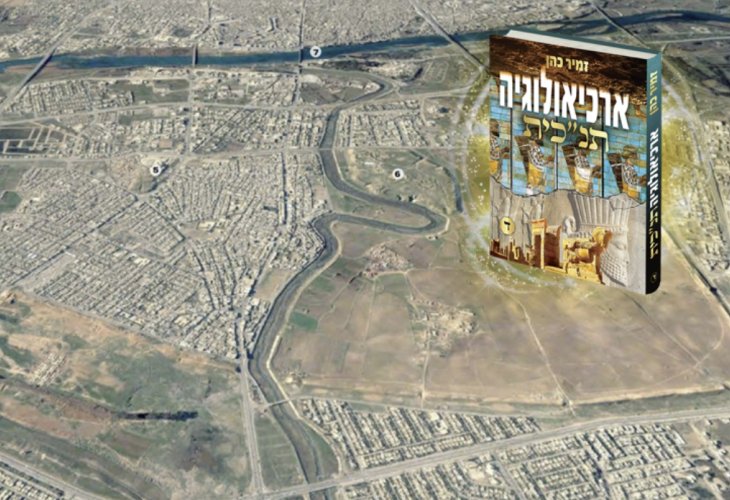 The ancient city of Nineveh today (Photo: Courtesy of Google)
The ancient city of Nineveh today (Photo: Courtesy of Google)In the late First Temple period, the Assyrian Empire dominated the land of Israel and much of the Middle East. This empire subdued many nations, tortured and killed countless war captives, and exiled the rest to foreign lands.
However, Assyria's time came to an end when it fell to a foreign conqueror. Rebellions against Assyria that began during the reign of its king Ashurbanipal intensified after his death. A leader of Chaldean descent named Nabopolassar launched a frontal rebellion against Assyria, aided by his allies: the Median kingdom and the fierce Scythian tribes.
The intervention of Pharaoh Necho, king of Egypt, who came with his army to assist Assyria, was ineffective. Nabopolassar first captured the city of Babylon, was crowned its king, and founded the Neo-Babylonian Empire. From there, he continued a broad and successful military campaign, and when he conquered and destroyed Nineveh, the capital of Assyria, it marked the end of the Assyrian Empire.
"Nineveh, the Great City"
The ruins of Nineveh, the grand city that served as the capital of the Assyrian Empire and was one of the ancient and famous cities of the world, lie today in the city of Mosul, northern Iraq, near the Tigris River.
In the Bible, Nineveh is mentioned as one of the first cities built after the flood, as it is written in the story of Noah:
"Cush begot Nimrod, he began to be a mighty one on the earth... And the beginning of his kingdom was Babel, Erekh, Akkad, and Calneh, in the land of Shinar. From that land Asshur went forth and built Nineveh."
These words are corroborated by researchers' findings, noting that "Nineveh is one of the oldest cities in Mesopotamia... the city held great strategic importance due to its location at a crucial crossroads."
This ancient city is also mentioned in the Code of Hammurabi, the Babylonian king, discovered in the archaeological excavations at the city of Susa. Hammurabi lived around the time of Abraham.
Another mention of Nineveh in the Bible, indicating the city's size, can be found in the Book of Jonah:
"The word of Hashem came to Jonah son of Amittai, saying, 'Arise, go to Nineveh, that great city, and call out against her.'"
"Nineveh, that great city, wherein are more than twelve times ten thousand people," "a walk of three days."
The Bible provides us with an illustration of the city's vast size, noting that it would take three days to walk from one end of Nineveh to the other (!). It is possible that this was also because this central and important city was densely populated, as indicated in the verse we mentioned earlier and in the words of the Sages that follow, hence movement within it was slow:
"Nineveh was a three-day walk. There were twelve markets, each with twelve thousand people. Every street had twelve entrances, and every entrance twelve courtyards, and each courtyard twelve houses."
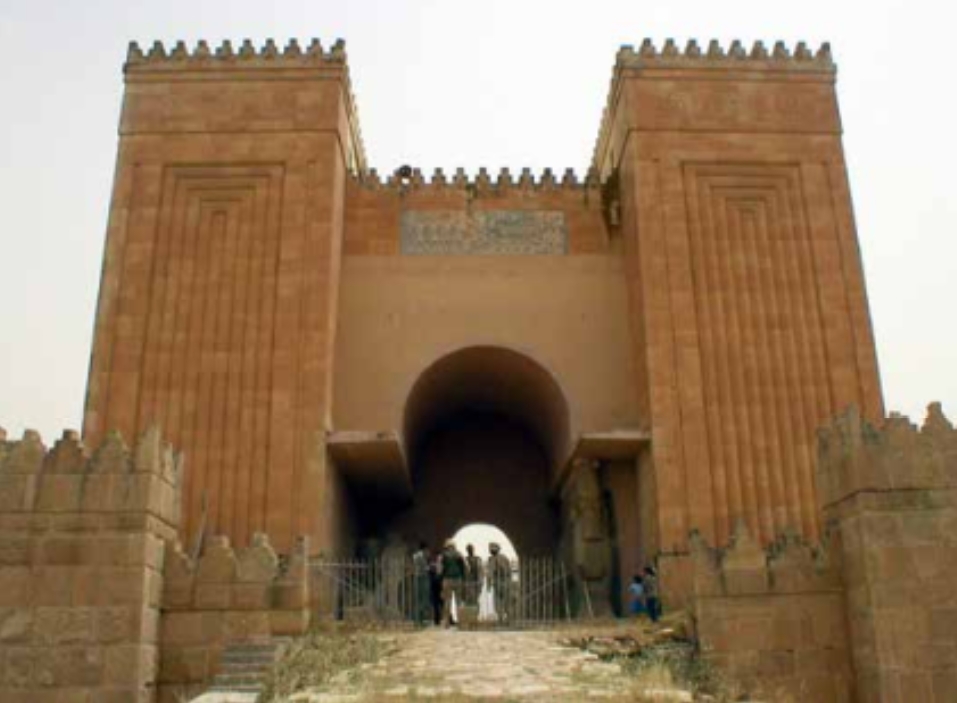 One of the gates of the ancient city of Nineveh, restored by the local government
One of the gates of the ancient city of Nineveh, restored by the local governmentThis description of Nineveh as a particularly large city with many structures is also reflected in archaeological research findings, which began in the area as early as the mid-19th century, spurred by the tradition surrounding the tomb of the prophet Jonah located in the region. Researchers found that Nineveh was one of the largest cities in the ancient East. They write:
"The discovery of the seven palaces of Nineveh, which had been forgotten by the time of Alexander the Great, was made possible thanks to the Arabs who named the hill Tel Nabi Yunus [Prophet Jonah], and according to their tradition, Jonah proclaimed his message to Nineveh on this hill. Based on this, Layard carried out excavations at this site, which were crowned with great success."
"The capital of the Assyrian kingdom... it turns out that the population of Nineveh during its heyday... was vast indeed...
The ancient citadel of Nineveh... rises up to thirty meters above its surroundings... Within its confines were also the Assyrian royal palaces and temples. South of the citadel lies a smaller hill, now called Nabi Yunus, which according to tradition houses the tomb of the prophet Jonah... the city spanned a much larger area. Sennacherib surrounded it with walls (part of which still exists) with a circumference of about sixteen kilometers... Excavations also revealed that Nineveh was a significant settlement from its inception."
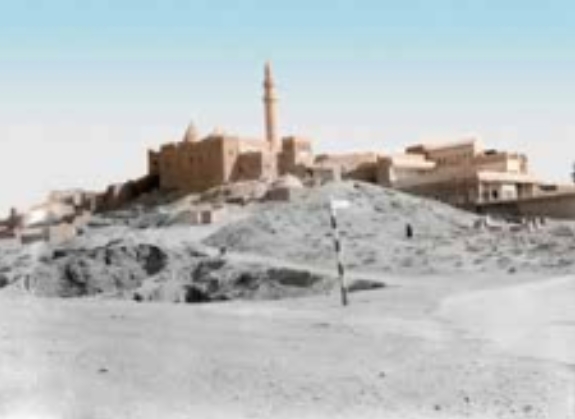 A structure in ancient Nineveh, strengthened by Muslim tradition as the site of Jonah's tomb. A photo from the early 20th century
A structure in ancient Nineveh, strengthened by Muslim tradition as the site of Jonah's tomb. A photo from the early 20th centuryAssyrian kings Tiglath-Pileser III, Sargon II, Sennacherib, Esarhaddon, Ashurbanipal, and others regarded the city and developed it. One of the notable discoveries of British archaeologist Austen Henry Layard, who explored the area, is the library of King Ashurbanipal, found in the ruins of a royal palace in Nineveh, at a site named "Tel Kuyunjik." "As the capital of the Assyrian Empire, Nineveh reached the height of its glory in the days of Ashurbanipal, who built a magnificent palace there... Ashurbanipal's library, found in Nineveh, with thousands of cuneiform tablets, contributed to the understanding of the city's history." The library is now housed in the British Museum and is known as the "Kuyunjik Collection."
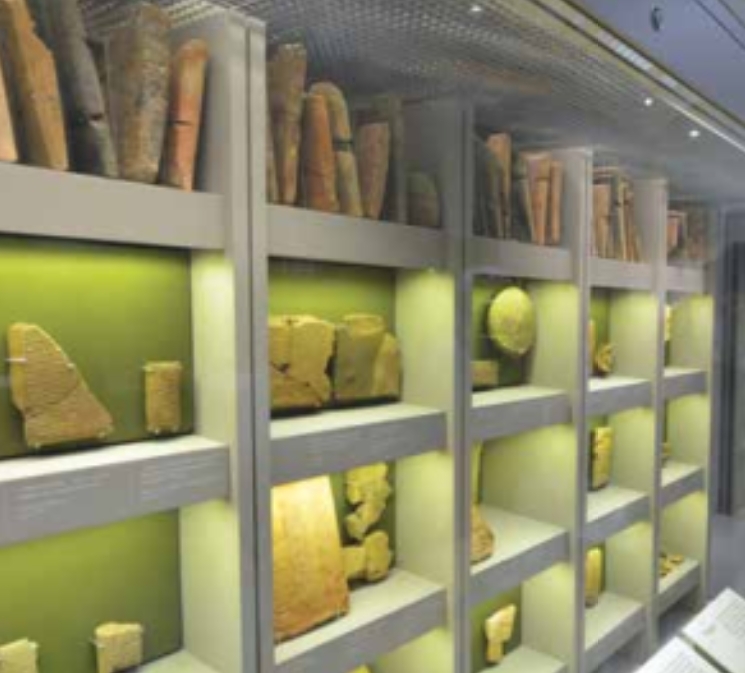 A tiny portion of the vast library of King Ashurbanipal, which resided in Nineveh. Now found in the British Museum (ChameleonsEye / Shutterstock.com)
A tiny portion of the vast library of King Ashurbanipal, which resided in Nineveh. Now found in the British Museum (ChameleonsEye / Shutterstock.com)Prophecies on the Fall of Assyrian Nineveh
Decades before Assyria's fall, Israeli prophets foretold that Hashem would hold these haughty conquerors accountable for their cruelty towards His people.
The punishment of the Assyrian Empire was prophesied by Isaiah the prophet:
"When Hashem has finished all His work on Mount Zion and in Jerusalem, He will punish the pride of the king of Assyria's heart and the haughty look of his eyes."
The prophet Nahum also forewarned of Nineveh's destruction:
"Woe to the city of blood, full of lies [woe to Nineveh, city of bloodshed, full of lies]...
Behold, I come to you, says Hashem of Hosts [I will fight against you]...
All who see you will run from you [keep away from you]
And will say: Despoiled [plundered] is Nineveh, who will mourn for her... Fire shall consume you, the sword will cut you off."
And also the prophet Zephaniah:
"He will stretch out His hand against the north and destroy Assyria; He will make Nineveh desolate, as dry as the desert."
Isaiah the Prophet's Seal?
In 2018, renowned archaeologist Dr. Eilat Mazar announced that a seal impression discovered in the Ophel excavation in ancient Jerusalem might belong to the prophet Isaiah. The seal bears the words "To Isaiah Nvi."
Isaiah son of Amoz was a prophet who lived in the Kingdom of Judah during the First Temple period, in the time of the kings Uzziah, Jotham, Ahaz, and Hezekiah. He is called "the greatest of the prophets" and came from a distinguished family: Amoz, his father, was also a prophet and the brother of Amaziah, King of Judah. The book of Isaiah describes his significant involvement in the kingdom's affairs and his deep connection with Hezekiah, further highlighted by Hezekiah marrying Isaiah's daughter.
The seal impression is dated to the late eighth or early seventh century BCE, indeed the days of Isaiah and Hezekiah. It was found very close to the supposed location of the royal palace of Judah in the Ophel, the same place where the personal seal impression of Hezekiah was discovered a few years earlier.
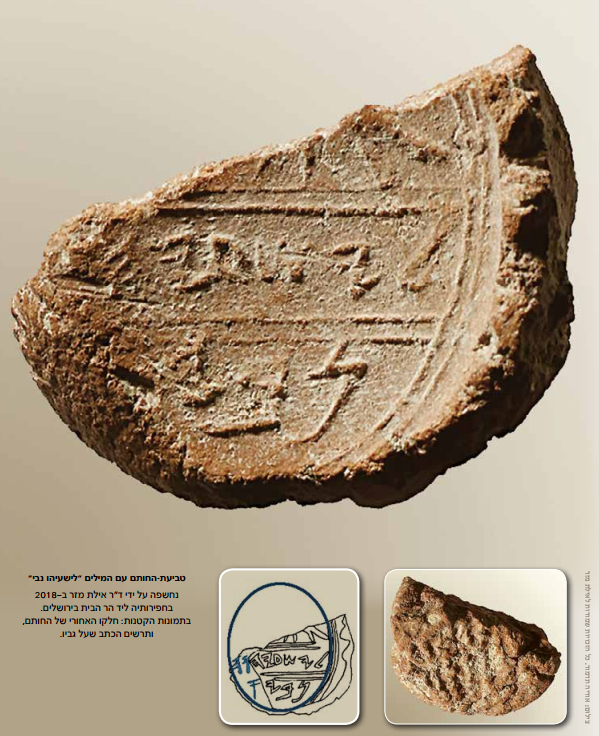 Seal impression with the words 'To Isaiah Nvi.' Discovered by Dr. Eilat Mazar in 2018 in her excavations near the Temple Mount in Jerusalem. In the small images: the back part of the seal, and the inscription sketch (Photo: Uriah Tadmor. All rights reserved to Eilat Mazar)
Seal impression with the words 'To Isaiah Nvi.' Discovered by Dr. Eilat Mazar in 2018 in her excavations near the Temple Mount in Jerusalem. In the small images: the back part of the seal, and the inscription sketch (Photo: Uriah Tadmor. All rights reserved to Eilat Mazar)The word "Nvi" on the seal impression could be an abbreviation of "prophet," as seals were typically inscribed without vowels due to their limited space.
Dr. Mazar notes that while there is no final proof this is Isaiah the prophet's seal, "finding Isaiah the prophet's seal impression near one of King Hezekiah is not unexpected... no figure was closer to King Hezekiah than Isaiah the prophet."
The Fall of Nineveh - The Gad Tablet
The prophecies we saw above, regarding Assyria's destruction, were fulfilled in 612 BCE when its capital, Nineveh, fell to the Babylonians and their allies, ending the Assyrian Empire. Nineveh, the splendid and bustling city, the capital of the mighty Assyrian empire that all the region's peoples feared, turned, as prophesied, "to desolation, as dry as the desert."
Is there any record from that time of this momentous event?
In 1923, British scholar Cyril John Gadd published that an ancient Babylonian document had been found in Iraq, describing Nabopolassar's military campaign and the conquest of Nineveh. The document is inscribed in Akkadian cuneiform on a clay tablet, a language common among Babylonians at the time. It was named the "Gad Chronicle" after the scholar who published it, and it gives a detailed account of Nabopolassar's military campaigns and victories. Here are selected excerpts from the document (noting the months by their Babylonian names, which were later adopted by the Babylonian exiles for use in the Hebrew calendar):
"(1) In the tenth year, in the month of Iyyar, Nabopolassar led his army...
(16) [In the eleventh year, the] king of Akkad [ Nabopolassar] led his army up the Tigris, and in the month of Iyyar, he camped opposite Assyria...
(23) In the month of Marcheshvan, the Medes came... and attacked the city...
(24) In the twelfth year, in the month of Av, the Medes attacked Nineveh...
(41) On the banks of the Tigris, they marched... against Nin[evvah]...
(42) From the month of Sivan to the month of Av, three battles...
(43) They attacked the city with great vigor, and in the month of Av [on...] the city fell... [and] there was great slaughter among the officials.
(44) At that time, Sin-shar-ishkun, the king of Assyria...
(45) The spoils of the city, an immeasurable amount, they plundered, and [they made] the city a pile of ruins and a [desolation]."
Assyrian Nineveh was left in desolation, as foretold by the prophets of Israel, and today only its remnants remain, surrounded by the later construction of the city of Mosul.
The city's magnificence during its peak can be evidenced by the remnants of its walls, still existing today as a high and long mound stretching for kilometers. Tests conducted on the mound revealed that it is not made of earth, as one might expect, but of a massive quantity of the bricks that made up the giant walls that crumbled over the millennia, creating the mound.
The Jewish traveler Rabbi Benjamin of Tudela, who toured the eastern lands in the 12th century, describes in his book what he saw in Nineveh and its long-standing walls: "From there, two days to Mosul... and between it and Nineveh, only the bridge remains, and it is deserted. However, within its ruins are villages and towns. The extent of Nineveh is discernible in its walls, spanning around forty parasangs to the city of Al-Bal."
Nabopolassar founded the new Babylonian empire, which henceforth became a potent force throughout the Middle East.
To purchase the book "Biblical Archaeology Part IV," click here.

